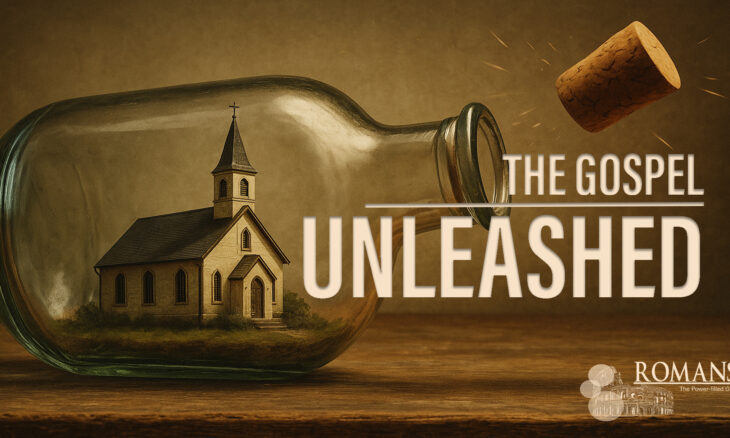Every small town has that one building that seems to hold the community together—a volunteer fire station, a school gym, or maybe a café where everyone knows your name. It’s not the size of the place that matters—it’s the people inside it—the ones who show up when someone’s hurting, who celebrate together, and who carry each other through hard times.
That’s what the church is meant to be—a place where the love of Christ turns ordinary people into something extraordinary together.
Paul saw that kind of strength in the believers at Rome. They weren’t perfect. They had disagreements, different cultures, and different ways of seeing the world—but they shared one Savior. In Romans 15, Paul reminds them that the real strength of a church isn’t found in its programs, buildings, or reputation—it’s found in its people: filled with the Spirit, committed to building each other up, keeping Christ at the center, giving generously, and praying boldly.
Romans 15 becomes Paul’s blueprint for a gospel-shaped church—one that doesn’t just survive in a divided world, but shines in it. So the question for us is simple: What kind of church are we becoming? Are we just a gathering of individuals, or a body—working together, lifting one another, and displaying the glory of Christ in all we do?
1. A Church That Builds One Another Up
Paul opens by affirming the believers in Rome: “You yourselves are full of goodness, filled with all knowledge and able to instruct one another” (Romans 15:14). Mature faith is not just about personal growth—it’s about shared growth. It’s not only what God is doing in me, but what He wants to do through me in others.
Think of a workout partner—they don’t lift the weights for you, but they make sure you don’t drop them. They challenge you when you’re tired, cheer you when you make progress, and keep you from giving up. A healthy church is filled with “spiritual spotters”—people who encourage, correct, and strengthen one another as we all grow in Christ.
Paul paints this same picture in Ephesians 4:11–16, describing the body of Christ as joined together, “building itself up in love, as each part does its work.” In a world that tears down, the gospel calls the church to build up—to lift, restore, and bear one another’s burdens (Galatians 6:2).
When God’s people use God’s Word to strengthen each other, the whole body becomes healthier—and the mission of Christ moves farther.
2. A Church That Keeps Christ Central
Paul continues, “I will not venture to speak of anything except what Christ has accomplished through me” (Romans 15:18). Even with his remarkable ministry record, Paul refuses to boast in himself. He knows every success is Christ’s work through him.
That’s what it means to keep Christ central—to see Him as the source, motive, and goal of everything we do. When Christ is at the center, pride fades and praise rises.
Like a stained-glass window, our lives are not meant to draw attention to ourselves but to let the light of Christ shine through us (2 Corinthians 4:5–7). When our ministries become about Him, not us, His glory takes the spotlight.
The question for us: Whose name are we really lifting up? A gospel-shaped church doesn’t exist to make itself known—it exists to make Jesus known.
3. A Church That Gives Generously
As Paul prepares to travel to Jerusalem, he carries a financial gift from Gentile believers for Jewish Christians in need (Romans 15:25–27). It’s not just generosity—it’s unity. In a divided world, giving became the bridge that united God’s people.
Paul reminds them that giving is not about obligation, but partnership (koinonia). When we give, we join God’s mission and share His heart. Generosity reflects the character of Christ, “who, though He was rich, became poor so that we might become rich” (2 Corinthians 8:9).
Whether it’s money, time, hospitality, or attention—generosity is a declaration that the gospel has freed us from self-centeredness. We give because God gave first. When the church gives like that, the world sees grace made visible.
4. A Church That Prays Boldly
Paul’s closing appeal in Romans 15 is striking: “Strive together with me in your prayers” (v. 30). The word strive (Greek agonizomai) means to wrestle, to labor with intensity. Even Paul, the great missionary, depends on the prayers of others.
Prayer is not an afterthought—it’s the church’s lifeline. It’s how we join together in the unseen battle, backing one another up like teammates protecting their quarterback or soldiers supporting the front line.
What if prayer became our reflex instead of our fallback? The early church changed the world not through influence or wealth but through prayer (Acts 4:31; Colossians 4:2–3). When God’s people pray boldly, dependence becomes our posture, and power becomes our story.
Conclusion: A Gospel-Shaped Church
When the church lives out Romans 15, something powerful happens.
- When we build one another up, the weak find strength.
- When we keep Christ central, pride gives way to purpose.
- When we give generously, the needs of others become opportunities for grace.
- When we pray boldly, God moves in ways no program ever could.
That kind of church is unstoppable—not because it’s big or famous, but because it’s faithful. It’s the kind of church Jesus prayed for in John 17 and the kind of church the world still needs to see today.
A gospel-shaped church is one that builds, centers, gives, and prays—becoming not just an institution, but a living testimony of God’s grace. That’s the kind of church we are called to be.














